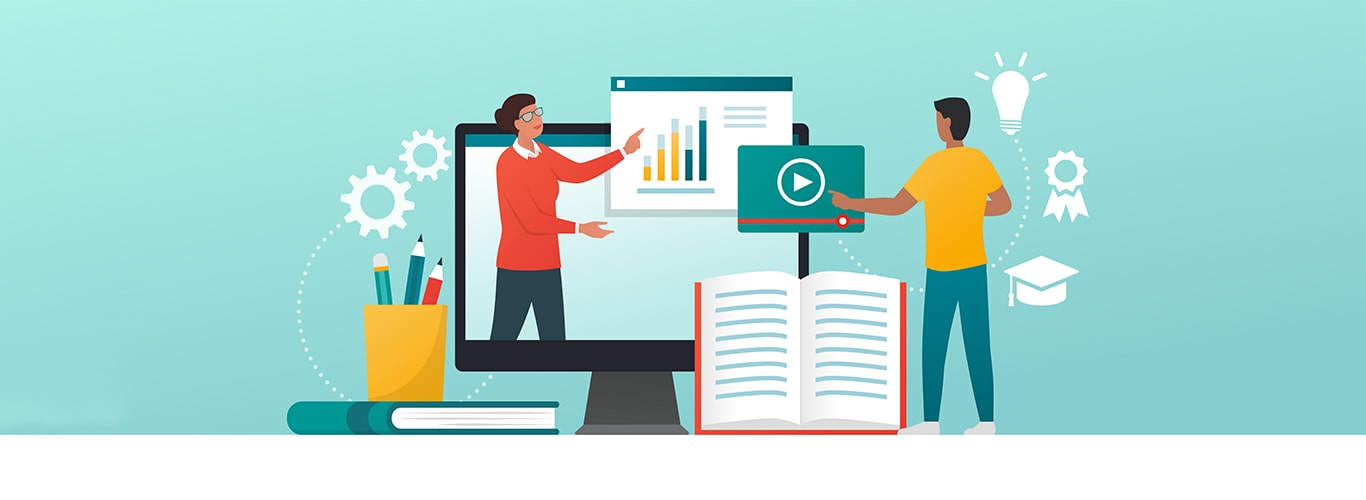
A look at Custom eLearning Solutions. Let us see how video-based eLearning-solutions have been simplifying learning.
Explaining how vast is the solar system, the complexities of a human brain, or simply the concept of fractions can primarily benefit from visual representation and Custom eLearning Solutions. Video-based eLearning-solutions have been simplifying learning and videos are fast becoming a widely accepted learning tool and are being pushed into the mainstream, especially during the pandemic. Shut away from physical schools, teachers most used “unorthodox” methods and may have hit a goldmine!
Let us look at how video-based elearning-solutions have been simplifying learning.
Here are some facts that the study confirms, which prove that video-based e-learning solutions are more effective than traditional methods.
1. Data backs Visual Learning
● Research shows that 65 per cent of the population are visual learners.
● The human brain processes visuals 60,000x faster than text
● Humans transmit and decode a visual within 1/10th of a second.
● Our brain is capable of registering visuals that last only for 13 milliseconds
● Also 40% of nerve fibers linked to our eyes (our retinas)
2. Visual Learning sticks in the long-term memory
Presently students retain visual information more than text. Eventually one of the easiest ways to ensure the retention of information in long-term memory is through visual cues. Pairing concepts with meaningful images makes the idea easy to comprehend and remember. Similarly visuals help students make sense of the content and help in focusing attention.
3. Contextualizing and enriching text
Students gain insights by contextualizing for example, the person, place, or object they’re learning about. like wise videos help them visualize an event. video-based e-learning solutions are an easier way of explaining because a lot of context in a short period without sending the learner into a sensory overload.
4. Visuals Act as Simulators for Emotions
Have you ever wondered why you can remember the route to a specific street but not the street’s name? It is because emotions and visual information are processed in the same brain area. Similarly visual input and the related emotional response linked because it translates as memories in the brain. While powerful visuals and visual metaphors influence learners and aid in retention.
5. It enables microlearning
Videos provide bite-sized information in a short period. This makes them perfect for microlearning. Microlearning is a way to learn new things by simultaneously acquiring small bits of data. The attention span of learners may vary and be relatively small. Sharing small bits of information in the form of short, interesting videos can help learners remember things for longer and make learning more meaningful.
Lets see few points to keep in mind if you want to use video-based learning to learn effectively:
● Write short texts
● Do make it engaging
● Make it fun and interactive
● Optimize it for various devices
● Keep things short(write short texts)
People often say that bite-size is just right. People are paying less attention online, so people who make e-learning content need to know how to get information across quickly. When learners only have to think about small pieces of information at a time, they are more likely to be interested and less likely to feel overwhelmed by a new subject. It also gives you a more manageable amount of content to work with since you won’t have to add too many interactive elements to keep your viewers interested the whole time.
● Keep it engaging
Videos are much more interesting by nature than other types of content. But that doesn’t mean that every video is interesting. If you only use text and images to show what you want to say, your video might look like a PowerPoint presentation. Your content will be well-balanced if you use different animations, graphics, and sounds.
● Make it fun and interactive
Adding interactive elements encourages your learners to take part in the content and use what they’ve learned immediately. For example, you could have your students watch a video scenario and answer questions after every few scenes. This makes room for interaction and gives context for making connections between the topic and things that happen in real life.
● Optimize it for various devices
Lastly, ensure that your content can be seen on various devices. If you’re making your video on a desktop, check how it looks on mobile and tablet devices often to ensure it’s optimized for different screen sizes. This ensures that learners can have a helpful learning experience on any device they have with them.
Below are few Tips for creating videos that add value to your learners :
● Videos that focus on people, things, or places
● Topics that are hard to understand or “text-heavy” in the syllabus
● One that helps students make connections between the known and the unknown
Visuals add a boost to the already existing text. E-learning solutions are the future of the education industry. Apps and software that find the perfect balance between visual and textual information can pave the way for a new learning method. Let Manipal Digital work with you towards this next step. We employ the ADDIE approach from analysis through final deployment to create tailored end-to-end custom e-learning solutions.



